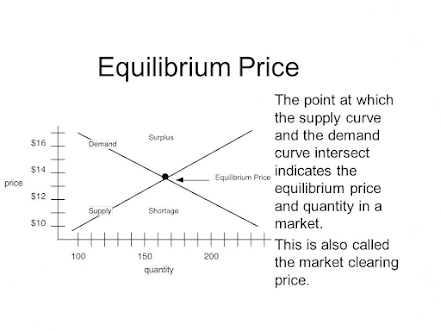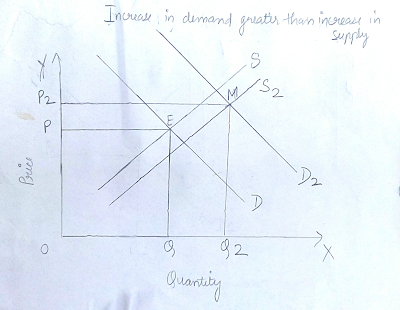In this article, Using demand and supply curves, we will diagrammatically demonstrate what happens to the equilibrium price and quantity when:
- An increase in demand that is greater than the increase in supply?
- Demand falls and supply is constant
What is Supply in Economics?
Supply in economics is defined as the total amount of a given product or service a supplier offers to consumers at a given period and a given price level. It is usually determined by market movement. For instance, a higher demand may push a supplier to increase supply.
$ads={1}
What is Demand?
Demand is the quantity of consumers who are willing and able to buy products at various prices during a given period of time. Demand for any commodity implies the consumers' desire to acquire the good, the willingness and ability to pay for it.
What is Equilibrium Price?
The equilibrium price is the price at which the quantity demanded equals the quantity supplied. It is determined by the intersection of the demand and supply curves.
A surplus exists if the quantity of a good or service supplied exceeds the quantity demanded at the current price; it causes downward pressure on price. A shortage exists if the quantity of a good or service demanded exceeds the quantity supplied at the current price; it causes upward pressure on price.
What is equilibrium quantity?
Equilibrium quantity is when there is no shortage or surplus of a product in the market. Supply and demand intersect, meaning the amount of an item that consumers want to buy is equal to the amount being supplied by its producers.
To determine what happens to equilibrium price and equilibrium quantity when both the supply and demand curves shift, you must know in which direction each of the curves shifts and the extent to which each curve shifts.
$ads={2}
When increase in demand is greater than increase in supply-
In the above diagram, D and S are the initial demand and supply curves respectively. E is the initial equilibrium point, P is the initial equilibrium price and Q is the initial equilibrium quantity. An increase in demand will shift the Demand curve to right from D to D2. An increase in supply will shift the supply curve to right from S to S2. As increase in demand is greater than increase in supply, Demand curve D2 will shift by greater distance than Supply curve S2 . From the given figure we can see that when increase in demand is greater than increase in supply, equilibrium price will rise and Equilibrium quantity will also increase. An increase in demand causes the a upward pressure on the price and an increase in Supply causes a downward pressure on the price. As increase in demand is more than increase in Supply, upward pressure on the price is more than downward pressure and hence, equilibrium price rises. As both Supply and demand has increased, equilibrium quantity will increase. In the above diagram, M is the new equilibrium point where new demand and supply curves intersect. We can see that as a result of increase in demand and supply, equilibrium price will increase to P2 and Equilibrium quantity will increase to Q2. Hence, when increase in demand is greater than increase in Supply, equilibrium price increases and Equilibrium quantity will also increase.
When Demand falls and Supply is constant-
In the above diagram, D and S are the initial demand and supply curves respectively. E is the initial equilibrium point, P is the initial equilibrium price and Q is the initial equilibrium quantity. As Demand will fall , demand curve will shift to the left from D to D1 . Supply curve S will remain the same. At the same Equilibrium price, a decrease in demand with Supply remaining the same, a surplus will occur in the market. Buyers seeing the unsold stock of goods will ask for lower price and suppliers, on the other hand, may start offering lower price to sell the unsold stock. In both the cases, a downward pressure is created on the price and hence, equilibrium price will fall. A fall in price will reduce the quantity supplied by suppliers. As demand has reduced has quantity Supplied has also reduced, equilibrium quantity will decrease. In the above diagram, A is the new equilibrium point. Equilibrium price has reduced to P1 and equilibrium quantity has also reduced to Q1. Hence, when Demand falls and Supply remains the same, both equilibrium price and Equilibrium quantity will decrease.




